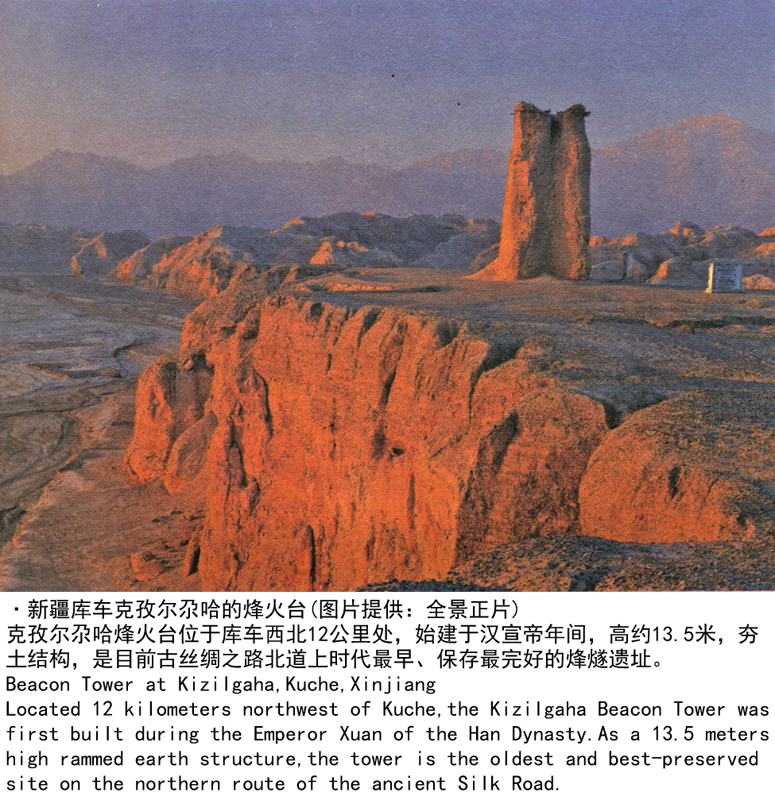丝路概说
- 交通路线
- 长安与丝绸之路
- 从长安到罗马——汉唐丝路全程探行纪实上
- 从长安到罗马——汉唐丝路全程探行纪实下
- 海上丝路史话
- 丝绸之路史研究
- 早期丝绸之路探微
- 早期丝绸之路文献研究
- 中西丝路文化史
- 沧桑大美丝绸之路
- 传播友谊的丝绸之路
- 路途漫漫丝貂情——明清东北亚丝绸之路研究
- 世界的中国——丝绸之路
- 丝绸之路
- 丝绸之路寻找失落的世界遗产
- 丝绸之路2000年
- 丝绸之路——从西安至帕米尔
- 丝绸之路经济带发展报告2014
- 丝绸之路考古十五讲
- 丝绸之路——神秘古国
- 丝绸之路——沿线城镇的兴衰
- 丝绸之路在中国
- 丝路景观
- 丝路起点长安
- 丝路文化新聚焦
- 丝路之光——创新思维与科技创新实践
- 中国丝绸之路交通史
- 中华文明史话-敦煌史话
- 中国·北海合浦海上丝绸之路始发港理论研讨会论文集
- 丝绸之路
- 丝绸之路新史
- 西域考古文存
- 丝绸之路的起源
▲库车
作者:方明


库车县位于中国新疆维吾尔自治区中西部,天山中段南麓,塔里木盆地北缘。库车古称“龟兹”,唐高僧玄奘在《大唐西域记》中称为“屈支”。
史志记载,古西域大国龟兹与中原内地交往历史悠久,在政治、军事、经济、文化上曾有重要地位。西汉时,龟兹是天山南部最有影响的王国之一,都城雄伟,素以出产良马、耕牛、细毡和香料著称。龟兹人善制金属刀器,且善酿葡萄酒。作为古代中外交通要道上的重要商埠,龟兹在汉时即有中原富商和胡商定居。胡商主要来自于当时的大秦和波斯等地。公元前60年汉朝置西域都护府时,龟兹受汉管辖,国王及其下属皆有汉朝廷颁发的印绶。东汉时班超平定西域,设都护府于龟兹,遣卒戍屯、引水开渠,龟兹的农业开始兴盛。龟兹受到中原经济文化影响越来越深,经济更为发达。到了魏晋时,龟兹一带已能种植水稻,并且成为西域的纺织中心。龟兹生产的白绁子布、花蕊布、织锦等远销各地。
隋朝到唐代前期,龟兹臣属于北方新兴的西突厥汗国。安史之乱爆发后,吐蕃乘机进逼西域。790年,龟兹被吐蕃攻占。不久,回鹘击败吐蕃,控制龟兹。11世纪以前,龟兹一直以佛教为国教,是西域小乘佛教的中心,境内有大量的佛教建筑和石窟等艺术作品。龟兹人能歌善舞,龟兹乐从西汉大将吕光西征时传入河西,北魏时传入中原,受到中原人民喜爱。入唐后,龟兹乐编为十部乐之一,对中国民族音乐的发展影响很大。约11世纪末,龟兹人脱离了回鹘,归附了哈喇汗王朝的喀什噶尔汗,皈依伊斯兰教。从此,龟兹不再是独立或半独立的政权,而先后成为哈喇汗、西辽、蒙古、元朝、准噶尔部等治下的地方行政单位,并于1758年归入清朝,定名“库车”。
今日库车的居民以维吾尔族为主,还有回族、柯尔克孜族、哈萨克族、蒙古族等众多少数民族。作为库车主体的维吾尔族,一方面保留着自己民族的优势和特色,一方面吸收、融合了其他民族的经验和智慧。
>Kuche
Kuche County is situated in the mid-west of China's Xinjiang Uygur Autonomous Region,southern foot of the middle section of the Tianshan Mountain and the northern edge of the Tarim Basin.Kuche was known as Qiuci in ancient times.In his book Buddhist Records of the Western World,the famous Tang Dynasty monk Xuan Zang referred to Qiuci as Quzhi.
It is recorded in historical chronicles,as a big power in the Western Regions in ancient times,Qiuci had a long history of connections with the Central Plains kingdoms and had an important position in the political,military,economic and cultural life.During the Western Han Dynasty,Qiuci was one of the most influential kingdoms south of the Tianshan Mountain.With a majestic capital city,Qiuci was well-known for its fine steed,cattle,fine felt and perfume.Qiuci people were also very good at making metal knives,and brewing good wines.As an important commercial port on the transportation artery in ancient times,many wealthy merchants from the Central Plains and from the northern and western regions settled in Qiuci as early as during the Han Dynasty.Most of the ethnic minority merchants came from the then Daqin and Persia.In 60 B.C,when the Han Dynasty established the Western Regions Frontier Command,Qiuci came under its jurisdiction.The King and his subordinates were all awarded printed ribbons by the imperial court of the Han Dynasty.After Ban Chao of the Eastern Han Dynasty pacified the Western Regions,the Western Regions Frontier Command was set up in Qiuci.Han Dynasty sent army to protect the villages,built irrigation systems to water the land.Agriculture began to flourish.With deepened economic and cultural influence from the Central Plains Quici became a more and more developed economy.By the Wei and the Jin dynasties,Qiuci became a rice growing area and a textile center in the Western Regions.Cloths produced in Quici such as white rope fabric,flower-patterned fabric and brocade were exported to many other places.
During the Sui Dynasty and the early Tang Dynasty,Quici was controlled under the Western Turks Khanate,a newly emerging power in the north.The outbreak of the Anshi Rebellion gave the Tibetans the opportunity to advance towards the Western Regions.In 790, Qiuci was taken over by the Tibetans.Not long after,the Uighurs defeated the Tibetans and controlled Qiuci.Prior to the 11th century,Buddhism was the national religion of Qiuci and the center of Theravada Buddhism in the Western Regions.There were large quantities of Buddhist architectures and works of art such as grottoes.Qiuci people were very good at singing and dancing.Qiuci music spread to Hexi area during the Western Han Dynasty when general Lü Guang took his westbound expedition.It then entered the Central Plains during the Northern Wei period and was loved by people in the Central Plains.The Tang Dynasty made Qiuci music one of the ten official music styles,a decision that produced great impact on the development of Chinese ethnic music.At about the end of the 11th century,Qiuci broke away from the rule of the Uighurs and submitted to the rule of Kashgar khan of the Kara-Khanid Khanate and converted to Islamism.Since then Qiuci stopped being an independent or semi-independent regime,and became a local administrative unit under the rule of the Kara-Khanid Khanate,Western Liao,Mongolia,the Yuan Dynasty,Zungar tribes.In 1758,Quici was incorporated into the Qing Dynasty and renamed Kuche.
Today,Uygur residents comprise the bulk of the population in Kuche.Others ethnic groups residing in Kuche include the Hui,Kirgiz,Kazak,Mongolia and many others.As the mainstay population,the Uygurs are not only preserving their own ethnic identity and special characteristics,they are also absorbing and integrating experiences and wisdoms of other ethnic groups.
丝绸之路/方明编著.-合肥: 黄山书社, 2013;